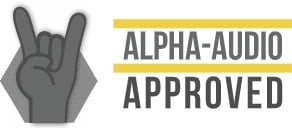

Listening
Contents
The first thing we notice is how phase coherent the ATCs are; there is an impressive consistency in the timing of the sound waves that travel from the two drivers to the listener. This makes it sound, we have no other word for it, credible. And after listening for a while, changing tracks, sources and cables, this impression is confirmed. We hear every change and not just that it sounds different, but also why and what causes it. And that makes listening to the SCM20A fascinating and addictive. Because it is as if these monitors allow us to truly hear how the recording should sound according to the musicians, the audio technicians and the conductor in the studio’s control room.
For example: Mooie Dag by Bløf is on our list of test tracks because it is a very spacious recording. Mastered in Wisseloord by Sander van der Heijden, we once listened to this recording with Sander in this studio. So we know how it should and can sound. The special thing is that the spatial effect on the ATCs is much more precise than we are used to. On the Tannoys, to name another extreme, the rhythm guitar surrounds us at 0:21, like a kind of 3D soundscape. The same thing happens with the different guitar and synthesiser effects in this song. The SCM20A also has this spatial effect, but it is much more controlled.
Jacques
Even when we play Jacques Loussier (Little Fugue, you know) we don’t hear the enormous oomph of the kick drum, the beat on the tom that disappears metres behind us or the piano keyboard that takes on wall-to-wall dimensions. It is exactly as it should be: a jazz trio syncopating a jazz fugue. And, not unimportantly, we don’t miss the sub-bass. It is often said that a subwoofer should be added to this monitor, but we do not share that opinion. There is enough bass to assess the track from a short distance. For the full bass, we can turn to the larger monitors in the studio.
Seeing with your ears
Let’s play classical music, Mendelssohn’s 4th symphony conducted by Lorin Maazel, recorded in 1961 (Deutsche Grammophon). We never cease to be amazed at how well the ‘Toningenieure’ of DG have produced classical recordings from the 50s and 60s. This recording is bursting with energy and it is bizarre how layered and energetic the orchestra sounds. The acoustics of the hall are simply tangible. My colleague Martijn can distinguish the mouthpieces of the flutes on this recording. I had the idea that I could see the shoe size of the cellist in the second row on the right (just bluffin’).
Then a music track taken from YouTube accidentally came through the speakers. The compression was so clearly audible and almost tangible that it was eerie and unbearable. Horrendous. On with the rest of the programme.
James
There is something about James Taylor; he always sounds good on ATC. We have experienced this before during a live stream with a big brother (or sister) of the SCM20A. The texture of his voice matches perfectly. It probably has something to do with the midrange, where James Taylor’s voice nestles in wonderfully.
It’s the midrange, once more

The midrange is the essence of a good mix. If the midrange is not properly worked out in the mix (per track, in the master), the final result will be a poor sounding master. And because there are unfortunately more mediocre than good mixes available, not to mention the remasters, the characteristics of most speakers have also changed. These compensate for the midrange by accentuating the bass and treble.
Why is the midrange so important? The answer to this question would be worth a separate article, but the short version is that we are evolutionarily attuned to the human voice in a frequency range of 500 to 2,000 Hz, with the emphasis on 1,000 Hz. This has to do with the fact that parents can distinguish the voice of their own child from that of other children. It is not for nothing that the crossover frequency of the SCM20A is set at 2,100Hz.
Throughout history, this ‘instrument’ has been the most important thing for us to hear, for communication and survival. So although the shape of our outer and inner ear has a lot to do with our hearing propensity, the brain has also been wired to key in on midrange (Paul Abbott, TapeOp).
On these ATCs, working on the midrange is a great pleasure. And listening to it is too. Seal’s album Standards, on which he recorded the classic Sinatra versions of the American Songbook, sounds fantastic. The acoustics of the Capitol Studios are clearly audible, Seal’s voice sounds distinct and layered, and here too we don’t miss the sub-bass for a moment.
Random Access Memories by Daft Punk was released in a ‘Drumless edition’; that’s right, the entire album without the drums. On the SCM20A we hear so much information that was simply inaudible on the original album due to the loud drums. Here we can clearly hear how detailed and perfectly produced the mix is by the robots of Daft Punk.










ATC SCM 20A Pro. You wrote under Cons:
“Everything is audible
Poorly mixed tracks are mercilessly exposed”
Aren’t those the point for a Pro studio speaker?
Yes, you are right that this is the point to pro monitor speakers.
Nevertheless, you would be surprised how many of these speakers perform differently compared to the ACM20A.
We have reviewed quite some professional monitors, please read these and this review. The list of pros and cons does not cover the full story.
Happy reading!